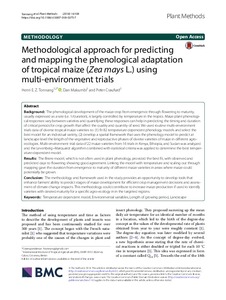| dc.contributor.author | Tonnang, H.E. |
| dc.contributor.author | Makumbi, Dan |
| dc.contributor.author | Craufurd, Peter Q. |
| dc.date.accessioned | 2019-12-04T11:33:53Z |
| dc.date.available | 2019-12-04T11:33:53Z |
| dc.date.issued | 2018 |
| dc.identifier.citation | Tonnang, H.E., Makumbi, D. & Craufurd, P. (2018). Methodological approach for predicting and mapping the phenological adaptation of tropical maize (Zea mays L.) using multi-environment trials. Plant Methods, 14(1), 108-119. |
| dc.identifier.issn | 1746-4811 |
| dc.identifier.uri | https://hdl.handle.net/20.500.12478/5836 |
| dc.description | Open Access Journal; Published online: 7 Dec 2018 |
| dc.description.abstract | Background
The phenological development of the maize crop from emergence through flowering to maturity, usually expressed as a rate (i.e. 1/duration), is largely controlled by temperature in the tropics. Maize plant phenological responses vary between varieties and quantifying these responses can help in predicting the timing and duration of critical periods for crop growth that affect the quality and quantity of seed. We used routine multi-environment trials data of diverse tropical maize varieties to: (1) fit 82 temperature dependent phenology models and select the best model for an individual variety, (2) develop a spatial framework that uses the phenology model to predict at landscape level the length of the vegetative and reproductive phases of diverse varieties of maize in different agro-ecologies. Multi-environment trial data of 22 maize varieties from 16 trials in Kenya, Ethiopia, and Sudan was analyzed and the Levenberg–Marquardt algorithm combined with statistical criteria was applied to determine the best temperature-dependent model.
Results
The Briere model, which is not often used in plant phenology, provided the best fit, with observed and predicted days to flowering showing good agreement. Linking the model with temperature and scaling out through mapping gave the duration from emergence to maturity of different maize varieties in areas where maize could potentially be grown.
Conclusion
The methodology and framework used in the study provides an opportunity to develop tools that enhance farmers’ ability to predict stages of maize development for efficient crop management decisions and assessment of climate change impacts. This methodology could contribute to increase maize production if used to identify varieties with desired maturity for a specific agro-ecology in in the targeted regions. |
| dc.description.sponsorship | Bill & Melinda Gates Foundation |
| dc.format.extent | 108-119 |
| dc.language.iso | en |
| dc.rights | CC-BY-4.0 |
| dc.subject | Maize |
| dc.subject | Environmental Factors |
| dc.subject | Maturity |
| dc.subject | Growth Period |
| dc.subject | Landscape |
| dc.subject | Methodological |
| dc.title | Methodological approach for predicting and mapping the phenological adaptation of tropical maize (Zea mays L.) using multi‑environment trials |
| dc.type | Journal Article |
| dc.description.version | Peer Review |
| cg.contributor.affiliation | International Institute of Tropical Agriculture |
| cg.contributor.affiliation | International Maize and Wheat Improvement Center |
| cg.coverage.region | Africa |
| cg.coverage.region | East Africa |
| cg.coverage.country | Ethiopia |
| cg.coverage.country | Kenya |
| cg.coverage.country | Sudan |
| cg.isijournal | ISI Journal |
| cg.authorship.types | CGIAR multi-centre |
| cg.iitasubject | Maize |
| cg.iitasubject | Meteorology And Climatology |
| cg.iitasubject | Research Method |
| cg.iitasubject | Socioeconomy |
| cg.journal | Plant Methods |
| cg.howpublished | Formally Published |
| cg.accessibilitystatus | Open Access |
| local.dspaceid | 105364 |
| cg.targetaudience | Scientists |
| cg.identifier.doi | http://dx.doi.org/10.1186/s13007-018-0375-7 |

